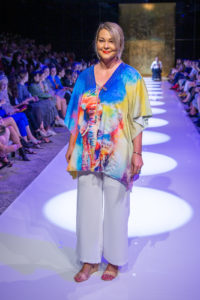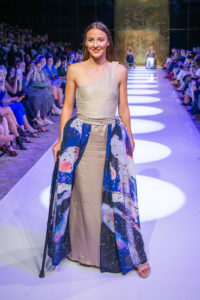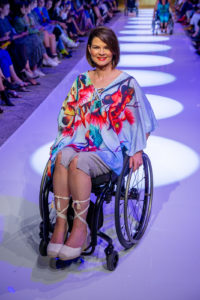
At the recent Next Gen Fashion Show, part of MBFF Brisbane, I was fortunate to see my first adaptive fashion collection. The MeQ collection was designed by Carol Taylor who is a mother, artist and lawyer. She also happens to be a quadriplegic, after being involved in a car accident eighteen years ago. Carol knows the problems people with a disability face when buying clothes and has been making her own designs for eighteen years. In what was probably a world first, the Brisbane Fashion Festival team, approached Carol to design nine pieces which opened the Next Gen show. It was a joyous show filled with colour, positivity and inclusivity.
All the models had disabilities and many were in wheelchairs, whilst model Jo Thomas can only feel the soles of her feet. It was a tremendous effort for her to walk the catwalk. One of my favourite designs was beautiful pink and black gown adorned with Carol’s art that was worn by model Bella Herman. The gown proudly showed off Bella’s prosthetic leg.
All models wore Carol’s beautiful creations and modelled them so elegantly with the audience responding enthusiastically. This Parade was one of the standout moments of the week for me and I had to speak to Carol to find out more.
I first asked Carol how she came to be involved with MBFF Brisbane.
She says, “In November 2018 I was fortunate enough to win the Queensland Access Arts Achievement Award. This was a $10,000 dollar award. For far too long people with a disability have been left out of the fashion conversation and I want to change that. My concept for the Award was to place my own artwork on fabric and create adapted fashion designs for people with a disability. To my knowledge I am the only quadriplegic designer designing for other quadriplegics and people with disability. I started with 4 waistcoats for a black tie dinner event and I approached the four guest speakers and asked whether I could design their waistcoats. I warned them that my artwork was very colourful, however they were happy for me to proceed. One thing led to another and the next thing I knew half of my wardrobe was on exhibition at Artisan Brisbane for two months. I was then asked whether I would like to design nine pieces for the Mercedes Benz Fashion Festival. I immediately agreed as this was too wonderful an opportunity to shine a spotlight on such an important issue. “
Remember most designers have a year to ready their collections. Carol only had 12 weeks, so she and her team were working night and day to have the garments ready in time for the show.
Carol laughs and says, “My collection was divided between two dressmakers and nine days out one of the dressmakers quit leaving an insurmountable load for the remaining dressmaker. I put out an urgent SOS on social media and two sewing angels came to my rescue…….. one of the dressmakers set her alarm for 2am on the day of the runway event to start sewing.”
You would never have known this watching the smiling models gliding along the runway on the night.
Carol explained some of the complications and adaptations that need to be made to make the garments more accessible for people with a disability.
“As a quadriplegic there are many problems that one faces when wearing shop bought clothing. Blood circulation is a real issue. That means that an ill- placed seam or zip in the wrong spot, which presses on the flesh, can create a pressure sore. Pressure sores are a constant worry for anyone who is in a wheelchair as it is very easy to be hospitalised for many months. One of the other issues people face is with temperature control. Even though I live in the tropical Gold Coast in Queensland my husband lights the fire at 5:30 am as the thermostat in my brain which controls body temperature no longer works properly. I can’t shiver to warm my body nor can I sweat properly to keep my body cool.”
Carol came up with many different ways to try and combat this. One was packing changes of clothes in her car, yet this was cumbersome and access was not always easy.
Carol explains her next idea, “I designed my caftans with a little secret pocket within themselves so that the caftan can essentially fold within itself into a drawstring bag contained in the front panel of the caftan. Once the caftan is in the drawstring bag then it is very easy to fit into my backpack which lives on the back of my wheelchair. “
This enables Carol to make a quick change when it is necessary.
She explains further, “There is another feature to my caftans that was born out of necessity. Like most quadriplegics I am drawn to the sun to soak up the warmth, once I have my 15- 20 minutes a day I’m set but the result of this sun exposure is that I have very brown forearms. So I designed a secret little sleeve panel that can be pulled on to release an extension of the sleeve. It is hidden near the shoulder and accessed by a press stud. Sun safe as well.”
Carol’s evening designs contain features like invisible and magnetic zips. “The beauty of using a magnetic zip is that someone with hand dexterity issues no longer has to struggle lining up one side of the zip with the other. The magnetic zip simply clasps together and is easy for an amputee, stroke victim or even someone with arthritis to do up. I was so grateful to Magzip in the USA for sponsoring me and providing all of the magnetic zips free of charge.”
I wondered if there was more material needed to make an adaptive evening gown but Carol assured me it was actually less.
She explains, “Shop bought evening gowns are the same length in the back as the front. All this excess fabric presents a dilemma when you are in a wheelchair and the fabric gets caught in the wheels. My evening dresses are designed to have less fabric at the back and are shaped to avoid collision with the front wheels.”
The hardest things for Carol when dressing are, “Not being able to stand at all. You also need help to get a top over your elbows and shoulders, so shop bought clothes have to be one to two sizes bigger which makes all your clothes look oversized.“
Her favourite fabrics to work with are a polyester cotton blend for the caftans, as it doesn’t crush and luxe velvet for evening as it is so forgiving. Most people in wheelchairs have a ‘quad pod’ caused by muscle atrophy. I design my clothing to work around my ‘ quad pod’ so that it is less noticeable.”
When Carol severed her spinal cord in 2001 she spiralled into acute depression and PTSD. Her husband knew he needed to help.
Carol continues, “He came home one day with an art enrolment in one hand and some modified brushes in the other. When we got to the art class the art teacher would only speak to my husband and no – one in the class would look me in the eye. I came home in tears and never returned.”
Yet it is a testament to Carol’s power and determination that she taught herself to paint from books and DVD’s before later being helped by her friend and mentor Maryann Homes.
Carol has since gone on to win numerous awards and has studied under some incredibly renowned artists. Whilst some quadriplegics have compromised hand function, Carol is completely paralysed from the chest down and her hands are completely paralysed with absolutely no finger movement. She can only move her wrist up and down.
Carol says , “After many years of therapy I have a very strong right shoulder. I paint with modified brushes and glide the paint across the paper with the use of my right shoulder.”
This talented Australian has brought this important conversation to the eyes of many through her hard work, design talent and never give up spirit. I ask would she consider her own fashion business.
Carol says, “I would love to create my own line and have already had so many enquiries from people asking when my clothing will be available. However I think it would make sense to either have an experienced mentor or collaborator. My background is not in fashion, it is in law. I have my own law firm Taylor Law Conveyancing which I set up in 2014. Yet I always loved fashion before my injury and will continue to love fashion but I have no formal fashion qualifications. I would happily make the transition.”
Thank you to Carol Taylor, the MBFF Brisbane Fashion Festival Team and the fabulous MeQ Collection models for shining a light on this important conversation. Carol is leading the way by showing us there are solutions for providing clothing for people with a disability that are user friendly, fashion forward and fun. With one in five Australians now living with a disability the clothing manufacturers ignore them at their peril.
Carol sums it up best by saying, “At the end of the day, I am still a woman armed with a credit card who wants to go shopping , buy glamorous things and look and feel beautiful. I am no different to any other woman ( or man) in this regard. I may be in a wheelchair but my fashion moves me forward.”
Carol Taylor is brave, whip-smart, artistic and compassionate and we at She Society applaud her for bringing this adaptive clothing range to our attention through an all inclusive show at MBFF Brisbane. She is a real ambassador for change, on a global scale, within the fashion industry and that is why #SheInspires.
Michelle Beesley is a Brisbane born and bred former primary school teacher. A wife, proud grandma and mother of three grown sons, Michelle is thrilled to have recently published her debut contemporary romance novel, It Happened in Paris, with Serenade Publishing. Her novella – Escape to D’ Amour was published in 2019. Michelle’s work can be found in the anthologies – Destination Romance and Short & Sweet. When not reading or writing Michelle can be found at a coffee shop chatting with friends, front row at a fashion show, or beside a rugby union field cheering on her favourite teams.
Michelle is a reluctant traveller, Francophile, keen walker and avid yoga enthusiast plus a book, film and theatre lover who loves everything pink and sparkly (including champagne). You can find Michelle on instagram @michellebeesley_writer and her website: michellebeesley.com.











Leave a Reply